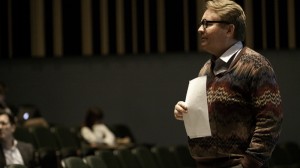
Last Wednesday, the Department of Visual Studies hosted a lecture open to the UTM student community. Students gathered in the CCT Building to hear professor and published author Alexander García Düttman discuss the nature of participation in art.
At the beginning of the presentation, students were encouraged to move to the bottom rows, making sure that a discussion could be engaged during the two-hour presentation. Düttman cautioned students that when it comes to art and participation in art, his approach to the topic can be unusual, even “oblique”. Within the first half of the lecture, Düttman stated that in order to participate with an art piece, there needs to be a sense of “otherness” that the viewer sees in the piece, or else there is nothing to comment on or participate in.
Düttman added that this otherness, or difference, can come from dreams, in which there can be a transition that artists may have between the new ideas they envision and knowledge that can be applied to their own artwork. Düttman then played an experimental art video, which he called a “political pamphlet”. The short French film, created to protest the closure of an important clinic in the centre of Paris, had a picture of its creator on the screen while rustling foliage and flies moved beneath the image. Throughout the two minutes, the voice of the film’s creator could be heard quoting lines from Genevan philosopher Jean-Jacques Rousseau’s essay “On the Origin of Inequality”.
After the viewing of the visual component, Düttman elaborated on the quotes, stating that the artist appropriated Rousseau’s words in hopes of creating an “impulse” in his audience to stand up and make a difference about the injustice happening in Paris at that moment. Düttman concluded by referring back to his idea of dreaming and knowing, and how the knowledge that an artist dreams up can only be seen as participation once there is some form of action taken, whether it be in the art itself or in the people that are inspired or moved by the art.
With a quirky blurb about German poet Friedrich Hölderlin, Düttman ended his lecture. As students began to leave and pack their things, murmurs of confusion filled the lecture hall. A lecture that had been billed as a straightforward approach to a topic had turned out to be rather philosophical, touching on political and revolutionary milestones, and the discussion about dreams seemed to transcend the concrete theories visual art students might be used to hearing.
As a student not in the visual studies program, the complicated discussion was a little clearer to me. However, rather than making me dismiss the lecture as cryptic and indecipherable, Düttman’s presentation gave me an idea of the inconclusiveness that can exist within the art world.
Like science, art is open to theory, interpretation, and questioning, and although hearing Düttman speak about something as abstract as participation was frustrating, the inconclusive nature of the discussion was also fascinating. When hearing the faint uncertainty that occasionally entered Düttman’s tone, I realized that even after years of research into the topic, defining participation in art is not only a difficult task, but the answer is difficult to communicate in a short two-hour lecture.


